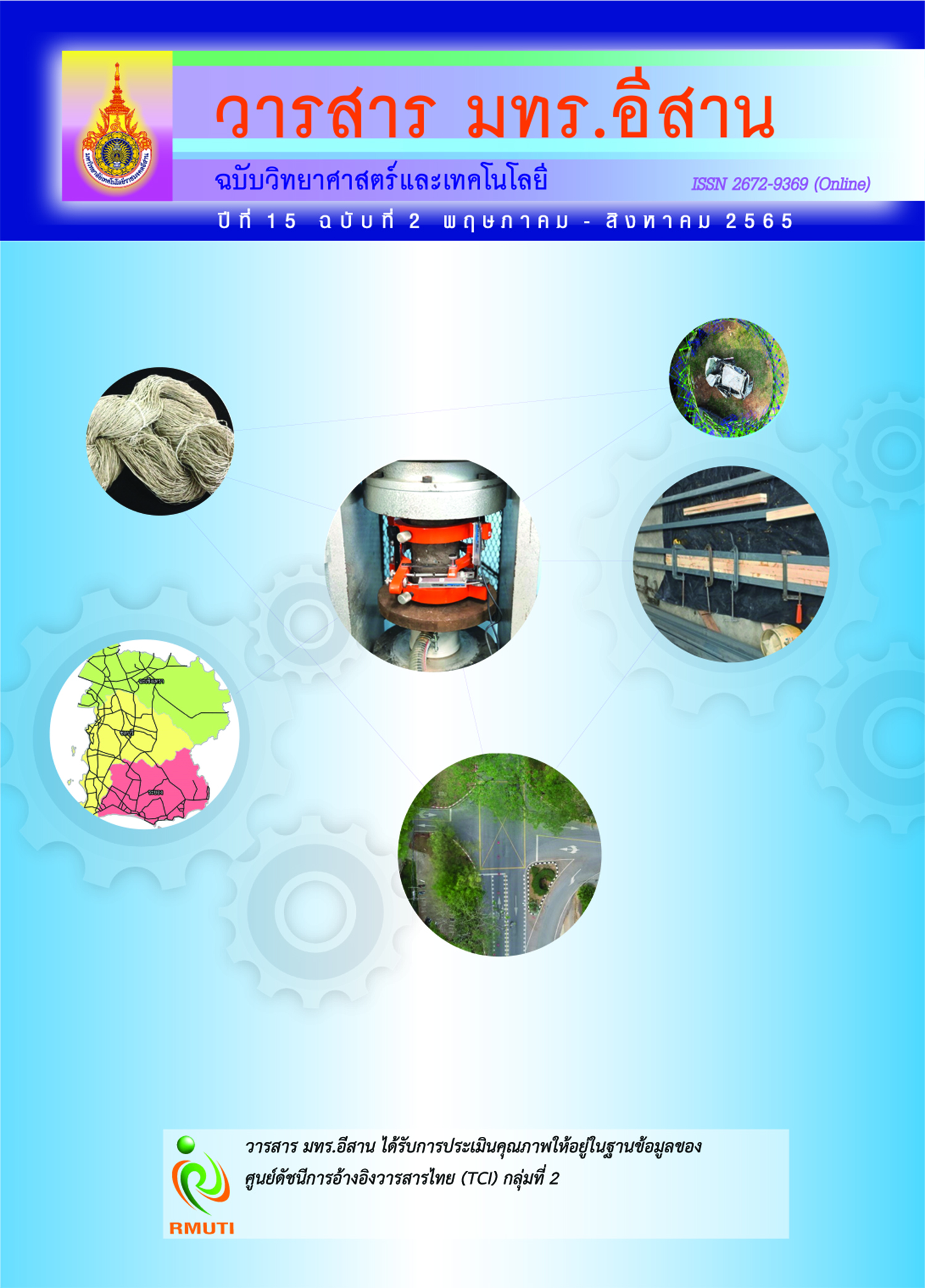An Optimization Study of Hot Water Generation from Solar PV/T Boosted Heat Pump; Case Study of Kai Nakorn Hotel, Vientiane Capital, Laos PDR
Main Article Content
Abstract
Kai Nakorn Hotel, Laos PDR has a demand for hot water with a temperature of 60 - 65 oC and an amount of 2,000 L/day for consumption. In the hot water production, a 20 kW heater coil was used resulting to 95.54 kWh/day of electricity consumption, which is a high energy use. Therefore, this research aimed to study an optimum size of the hot water production system from Solar PV/T Boosted Heat Pump for hot water use in the Kai Nakorn Hotel in order to reduce the amount of electricity consumption. The first part was testing the electrical and thermal performance of the Solar PV/T following Standard testing to simulate a performance prediction equation of a 330 Wp Solar PV/T. The results revealed that the thermal performance of Solar PV/T panels obtained FR(τα)e and FRUL equal to 0.4018 and 10.466 W/m2•oC, respectively. The averaged power generation efficiency of solar PV/T panel was 16 % and an empirical equation for prediction performance of hot water generation with Solar PV/T Boosted Heat Pump was obtained. In the second part of the study, the equations that were obtained from the first part of the study were used to create a mathematical model to design an optimized system and analyze the cost-effectiveness for choosing the appropriate size of the hot water use in hotel. The conventional hot water production system used an electric heater of 20 kW to produce 2,000 L/day hot water at a temperature of 60 - 65 oC. The results showed that the optimized system used 330 Wp solar PV/T with 12 panels together with a 17.8 kWth heat pump. The electricity consumption was able to reduce by 28,072.71 kWh/year, or equivalent to the electricity costs of 86,952.84 Baht/year. The investment was 604,180 Baht and the payback period was 7.13 years.
Article Details

This work is licensed under a Creative Commons Attribution-NonCommercial-NoDerivatives 4.0 International License.
References
Sonsaree, S., Asaoka, T., Jiajitsawat, S., Aguiree, H., and Tanaka, K. (2017). VCHP-ORC Power Generation from Low-Grade Industrial Waste Heat Combined with Solar Water Heating System: Power Generation and CO2 Emission in Industrial Estate of Thailand. Cogent Engineering. Vol. 4, Issue 1, p. 1359397. DOI: 10.1080/23311916.2017.1359397
Suwanasang, N. and Tongsopit, S. (2015). An Assessment of the Technical and Economic Potential of Rooftop Solar Systems on Chulalongkorn University’s Buildings. Journal of Energy Research. Vol. 12, No. 2, pp. 59-74. (in Thai)
Ministry of Energy (2009). Technology of Using Heat Pumps for Heating. Bangkok: In-depth Technology Demonstration Project for Energy Conservation. Department of Alternative Energy Development and Efficiency. (in Thai)
Sun, X., Dai, Y., Novakovic, V., Wu, J., and Wang, R. (2015). Performance Comparison of Direct Expansion Solar-Assisted Heat Pump and Conventional Air Source Heat Pump for Domestic Hot Water. Energy Procedia. Vol. 70, pp. 394-401. DOI: 10.1016/j.egypro.2015.02.140
Herrando, M., Ramos, A., Zabalza, L., and Markides, C. N. (2019). A Comprehensive Assessment of Alternative Absorber-Exchanger Designs for Hybrid PV/T-Water Collectors. Appilied Energy. Vol. 235, pp. 1583-1602. DOI: 10.1016/j.apenergy.2018.11.024
Huide, F., Xuxin, Z., Lei, M., Tao, Z., Qixing, W., and Hongyuan, S. (2017). A Comparative Study on Three Types of Solar Utilization Technologies for Buildings: Photovoltaic, Solar Thermal and Hybrid Photovoltaic/Thermal Systems. Energy Conversion and Management. Vol. 140, pp. 1-13. DOI: 10.1016/j.enconman.2017.02.059
Chanthaseng, S. and Mongkon, S. (2021). Experimental Performance of Hot Water Production by Solar PV/T Boosted Heat Pump System for Electricpower Costs Reduction in a Slaughterhouse. Engineering Journal Chiang Mai University. Vol. 28, No. 1,
pp. 110-126. (in Thai)
Wanchupela, N. and Polvongsri, S. (2021). Size and Type Optimization of Solar Photovoltaic Thermal Hybrid Assisted Heat Pump in Slaughterhouse. Engineering Journal Chiang Mai University. Vol. 28, No. 1, pp. 127-140. (in Thai)
Chanthaboune, V. and Kiatsiriroat, T. (2007). Performance Testing of a Solar Assisted Heat Pump Water by using an Unglazed Flat-plate Solar Collector as an Evaporator. In Conference on Thermal Energy and Mass Transfer in Thermal Devices. Chiang Mai
University, Chiang Mai Province. 15-16 Mar, Amora Chiang Mai, 2550. (in Thai)
Chaichana, C., Kiatsiriroat, T., and Nuntaphan, A. (2010). Comparison of Conventional Flat-Plate Solar Collector and Solar Boosted Heat Pump Using Unglazed Collector for Hot Water Production in Small Slaughterhouse. Heat Transfer Engineering. Vol. 31, Issue 5, pp. 419-429. DOI: 10.1080/01457630903375475
Jie, J., Keliang, L., Tin-tai, C., Gang, P., Wei, H., and Hanfeng, H. (2008). Performance Analysis of a Photovoltaic Heat Pump. Applied Energy. Vol. 85, Issue 8, pp. 680-693. DOI: 10.1016/j.apenergy.2008.01.003
Saysana Chanthaseng. (2021). Energy Cost Reduction of Slaughterhouse with Hot Water Generation from Solar Photovoltaic Thermal Hybrid Booted Heat Pump. Thesis, Master of Engineering in Renewable Energy Engineering, School of Renewable
Energy, Maejo University. (in Thai)
NASA POWER Data Access Viewer. (2020). Solar Radiation and Ambient Temperature. Access (17 May 2021). Available (https://power.larc.nasa.gov/data-access-viewer/?fbclid=IwAR21o8oBtosEgetYzfm0HfWGFM3G6XfJ_t1nFLLBFNv-ito6j6mN_iYavkk).
Anderson, T. N., Morrison, G. L., and Behnia, M. (2003). An Experimental Evaluation of an Air Source and a Solar Boosted Heat Pump Water Heater. Destination Renewables - ANZSES

